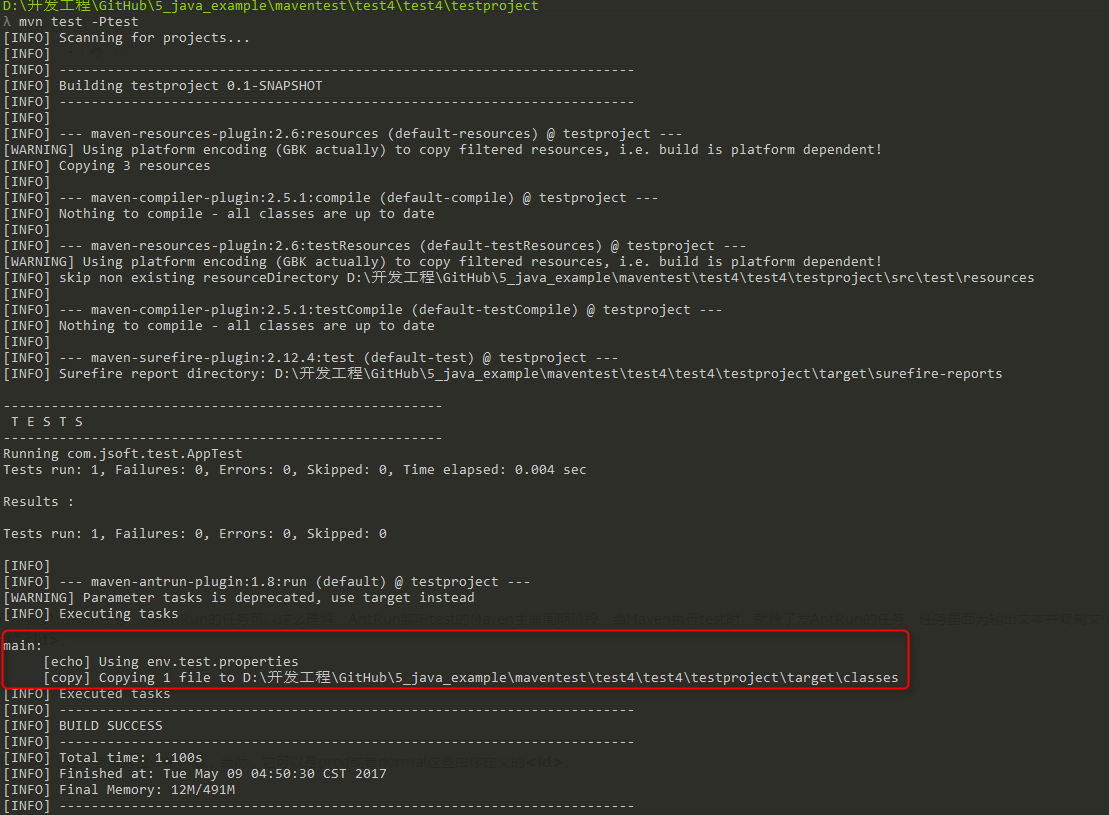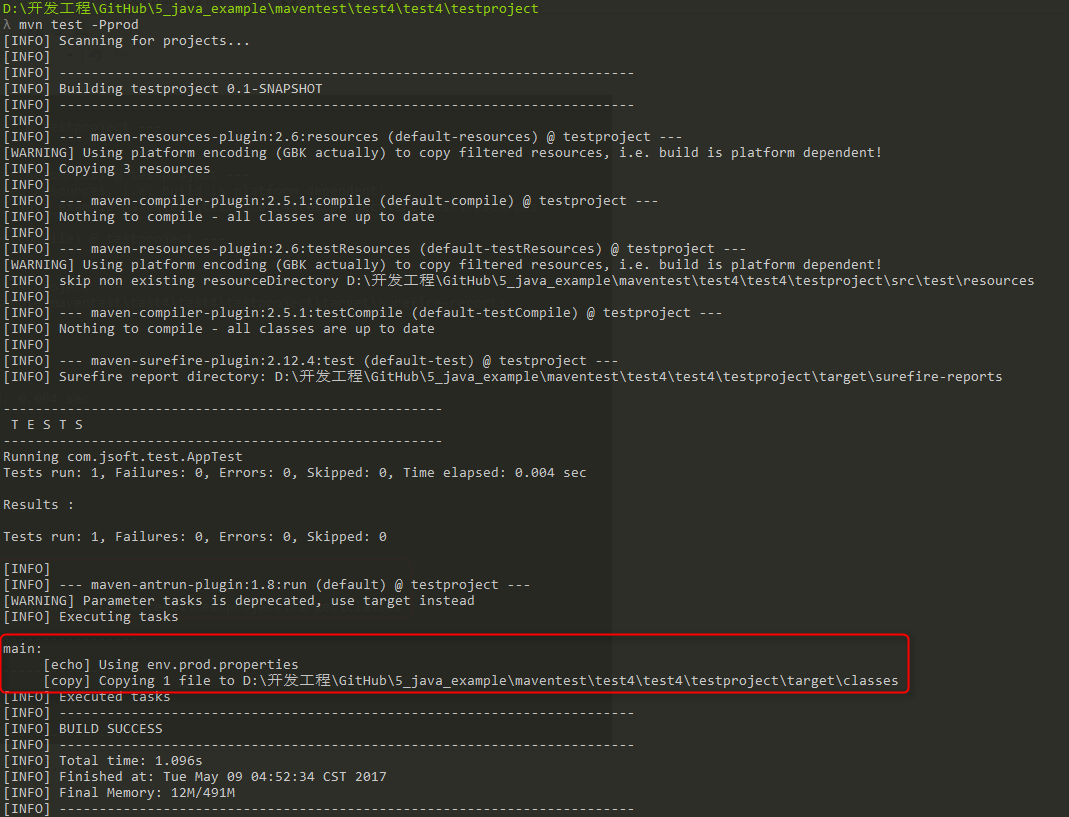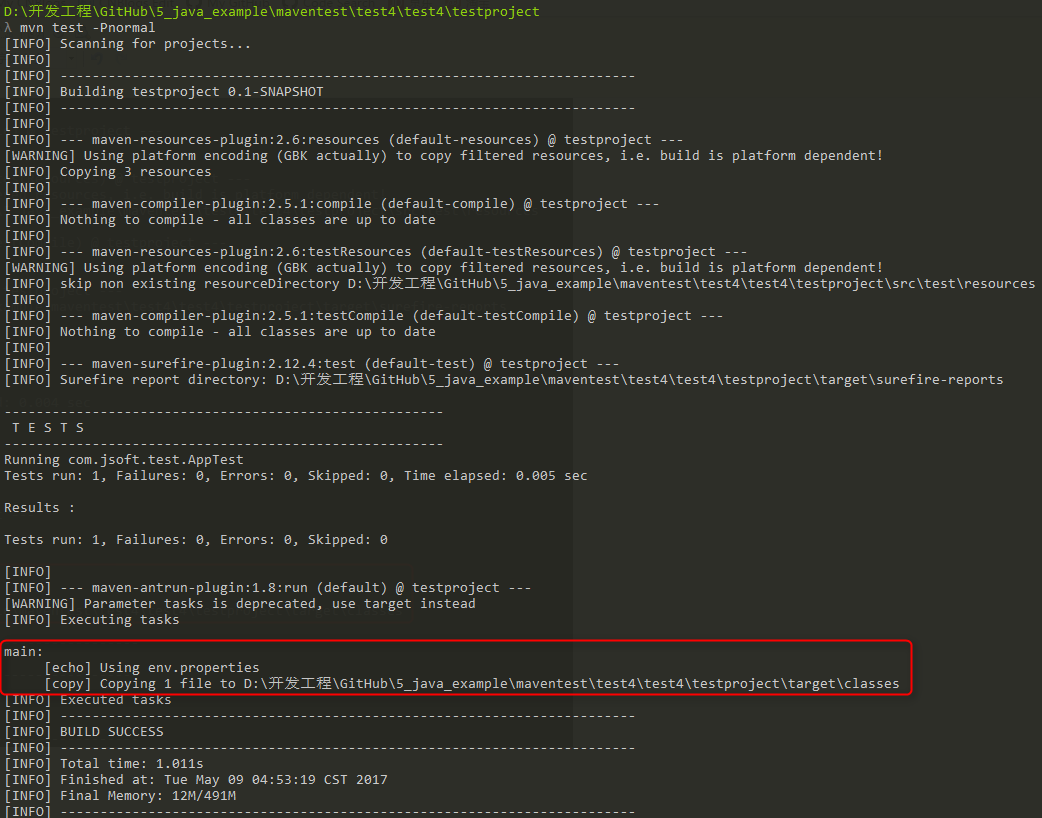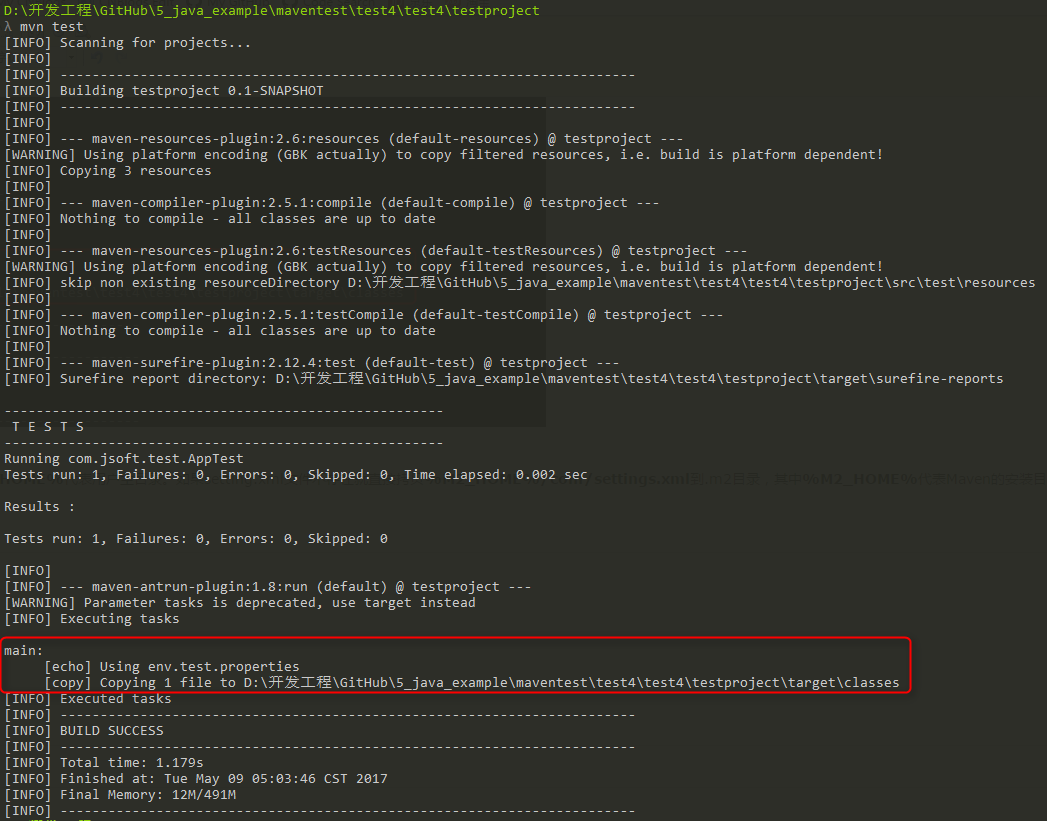Maven 構建配置檔
構建配置檔是一系列的配置項的值,可以用來設置或者覆蓋 Maven 構建默認值。
使用構建配置檔,你可以為不同的環境,比如說生產環境(Production)和開發(Development)環境,定制構建方式。
配置檔在 pom.xml 檔中使用 activeProfiles 或者 profiles 元素指定,並且可以通過各種方式觸發。配置檔在構建時修改 POM,並且用來給參數設定不同的目標環境(比如說,開發(Development)、測試(Testing)和生產環境(Production)中資料庫伺服器的地址)。
構建配置檔的類型
構建配置檔大體上有三種類型:
| 類型 | 在哪定義 |
|---|
| 專案級(Per Project) |
定義在專案的POM檔pom.xml中 |
| 用戶級 (Per User) |
定義在Maven的設置xml檔中 (%USER_HOME%/.m2/settings.xml) |
| 全局(Global) |
定義在 Maven 全局的設置 xml 檔中 (%M2_HOME%/conf/settings.xml) |
配置檔啟動
Maven的構建配置檔可以通過多種方式啟動。
- 使用命令控制臺輸入顯式啟動。
- 通過 maven 設置。
- 基於環境變數(用戶或者系統變數)。
- 操作系統設置(比如說,Windows系列)。
- 檔的存在或者缺失。
配置檔啟動實例
假定專案結構如下:

其中在src/main/resources檔夾下有三個用於測試檔:
| 檔案名 | 描述 |
|---|
| env.properties |
如果未指定配置檔時默認使用的配置。 |
| env.test.properties |
當測試配置檔使用時的測試配置。 |
| env.prod.properties |
當生產配置檔使用時的生產配置。 |
注意:這三個配置檔並不是代表構建配置檔的功能,而是用於本次測試的目的;比如,我指定了構建配置檔為 prod 時,專案就使用 envprod.properties檔。
注意:下麵的例子仍然是使用 AntRun 插件,因為此插件能綁定 Maven 生命週期階段,並通過 Ant 的標籤不用編寫一點代碼即可輸出資訊、複製檔等,經此而已。其餘的與本次構建配置檔無關。
1、配置檔啟動
profile 可以讓我們定義一系列的配置資訊,然後指定其啟動條件。這樣我們就可以定義多個 profile,然後每個 profile 對應不同的啟動條件和配置資訊,從而達到不同環境使用不同配置資訊的效果。
以下實例,我們將 maven-antrun-plugin:run 目標添加到測試階段中。這樣我們可以在不同的 profile 中輸出文本資訊。我們將使用 pom.xml 來定義不同的 profile,並在命令控制臺中使用 maven 命令啟動 profile。
pom.xml 檔如下:
<project xmlns="http://maven.apache.org/POM/4.0.0" xmlns:xsi="http://www.w3.org/2001/XMLSchema-instance"
xsi:schemaLocation="http://maven.apache.org/POM/4.0.0 http://maven.apache.org/maven-v4_0_0.xsd">
<modelVersion>4.0.0</modelVersion>
<groupId>com.jsoft.test</groupId>
<artifactId>testproject</artifactId>
<packaging>jar</packaging>
<version>0.1-SNAPSHOT</version>
<name>testproject</name>
<url>http://maven.apache.org</url>
<dependencies>
<dependency>
<groupId>junit</groupId>
<artifactId>junit</artifactId>
<version>3.8.1</version>
<scope>test</scope>
</dependency>
</dependencies>
<profiles>
<profile>
<id>test</id>
<build>
<plugins>
<plugin>
<groupId>org.apache.maven.plugins</groupId>
<artifactId>maven-antrun-plugin</artifactId>
<version>1.8</version>
<executions>
<execution>
<phase>test</phase>
<goals>
<goal>run</goal>
</goals>
<configuration>
<tasks>
<echo>Using env.test.properties</echo>
<copy file="src/main/resources/env.test.properties" tofile="${project.build.outputDirectory}/env.properties" overwrite="true"/>
</tasks>
</configuration>
</execution>
</executions>
</plugin>
</plugins>
</build>
</profile>
<profile>
<id>normal</id>
<build>
<plugins>
<plugin>
<groupId>org.apache.maven.plugins</groupId>
<artifactId>maven-antrun-plugin</artifactId>
<version>1.8</version>
<executions>
<execution>
<phase>test</phase>
<goals>
<goal>run</goal>
</goals>
<configuration>
<tasks>
<echo>Using env.properties</echo>
<copy file="src/main/resources/env.properties" tofile="${project.build.outputDirectory}/env.properties" overwrite="true"/>
</tasks>
</configuration>
</execution>
</executions>
</plugin>
</plugins>
</build>
</profile>
<profile>
<id>prod</id>
<build>
<plugins>
<plugin>
<groupId>org.apache.maven.plugins</groupId>
<artifactId>maven-antrun-plugin</artifactId>
<version>1.8</version>
<executions>
<execution>
<phase>test</phase>
<goals>
<goal>run</goal>
</goals>
<configuration>
<tasks>
<echo>Using env.prod.properties</echo>
<copy file="src/main/resources/env.prod.properties" tofile="${project.build.outputDirectory}/env.properties" overwrite="true"/>
</tasks>
</configuration>
</execution>
</executions>
</plugin>
</plugins>
</build>
</profile>
</profiles>
</project>
注意:構建配置檔採用的是 <profiles> 節點。
說明:上面新建了三個 <profiles>,其中 <id> 區分了不同的 <profiles> 執行不同的 AntRun 任務;而 AntRun 的任務可以這麼理解,AntRun 監聽 test 的 Maven 生命週期階段,當 Maven 執行 test 時,就除了發 AntRun 的任務,任務裏面為輸出文本並複製檔到指定的位置;而至於要執行哪個 AntRun 任務,此時構建配置檔起到了傳輸指定的作用,比如,通過命令行參數輸入指定的 <id>。
執行命令:
mvn test -Ptest
提示:第一個 test 為 Maven 生命週期階段,第 2 個 test 為構建配置檔指定的 <id> 參數,這個參數通過 -P 來傳輸,當然,它可以是 prod 或者 normal 這些由你定義的<id>。
運行的結果如下:

可以看出成功的觸發了AntRun的任務。並且是對應構建配置檔下的 <id> 為 test 的任務。
再測試其餘兩個命令,結果如下:


2、通過Maven設置啟動配置檔
打開 %USER_HOME%/.m2 目錄下的 settings.xml 檔,其中 %USER_HOME% 代表用戶主目錄。如果 setting.xml 檔不存在就直接拷貝 %M2_HOME%/conf/settings.xml 到 .m2 目錄,其中 %M2_HOME% 代表 Maven 的安裝目錄。
配置 setting.xml 檔,增加 <activeProfiles>屬性:
<settings xmlns="http://maven.apache.org/POM/4.0.0"
xmlns:xsi="http://www.w3.org/2001/XMLSchema-instance"
xsi:schemaLocation="http://maven.apache.org/POM/4.0.0
http://maven.apache.org/xsd/settings-1.0.0.xsd">
...
<activeProfiles>
<activeProfile>test</activeProfile>
</activeProfiles>
</settings>
執行命令:
mvn test
提示 1:此時不需要使用 -Ptest 來輸入參數了,上面的 setting.xml 檔的 <activeprofile> 已經指定了 test 參數代替了。
提示 2:同樣可以使用在 %M2_HOME%/conf/settings.xml 的檔進行配置,效果一致。
執行結果:

3、通過環境變數啟動配置檔
先把上一步測試的 setting.xml 值全部去掉。
然後在 pom.xml 裏面的 <id> 為 test 的 <profile> 節點,加入 <activation> 節點:
<project xmlns="http://maven.apache.org/POM/4.0.0" xmlns:xsi="http://www.w3.org/2001/XMLSchema-instance"
xsi:schemaLocation="http://maven.apache.org/POM/4.0.0 http://maven.apache.org/maven-v4_0_0.xsd">
<modelVersion>4.0.0</modelVersion>
<groupId>com.jsoft.test</groupId>
<artifactId>testproject</artifactId>
<packaging>jar</packaging>
<version>0.1-SNAPSHOT</version>
<name>testproject</name>
<url>http://maven.apache.org</url>
<dependencies>
<dependency>
<groupId>junit</groupId>
<artifactId>junit</artifactId>
<version>3.8.1</version>
<scope>test</scope>
</dependency>
</dependencies>
<profiles>
<profile>
<id>test</id>
<activation>
<property>
<name>env</name>
<value>test</value>
</property>
</activation>
<build>
<plugins>
<plugin>
<groupId>org.apache.maven.plugins</groupId>
<artifactId>maven-antrun-plugin</artifactId>
<version>1.8</version>
<executions>
<execution>
<phase>test</phase>
<goals>
<goal>run</goal>
</goals>
<configuration>
<tasks>
<echo>Using env.test.properties</echo>
<copy file="src/main/resources/env.test.properties" tofile="${project.build.outputDirectory}/env.properties" overwrite="true"/>
</tasks>
</configuration>
</execution>
</executions>
</plugin>
</plugins>
</build>
</profile>
<profile>
<id>normal</id>
<build>
<plugins>
<plugin>
<groupId>org.apache.maven.plugins</groupId>
<artifactId>maven-antrun-plugin</artifactId>
<version>1.8</version>
<executions>
<execution>
<phase>test</phase>
<goals>
<goal>run</goal>
</goals>
<configuration>
<tasks>
<echo>Using env.properties</echo>
<copy file="src/main/resources/env.properties" tofile="${project.build.outputDirectory}/env.properties" overwrite="true"/>
</tasks>
</configuration>
</execution>
</executions>
</plugin>
</plugins>
</build>
</profile>
<profile>
<id>prod</id>
<build>
<plugins>
<plugin>
<groupId>org.apache.maven.plugins</groupId>
<artifactId>maven-antrun-plugin</artifactId>
<version>1.8</version>
<executions>
<execution>
<phase>test</phase>
<goals>
<goal>run</goal>
</goals>
<configuration>
<tasks>
<echo>Using env.prod.properties</echo>
<copy file="src/main/resources/env.prod.properties" tofile="${project.build.outputDirectory}/env.properties" overwrite="true"/>
</tasks>
</configuration>
</execution>
</executions>
</plugin>
</plugins>
</build>
</profile>
</profiles>
</project>
執行命令:
mvn test -Denv=test
提示 1:上面使用 -D 傳遞環境變數,其中 evn 對應剛才設置的 <name> 值,test 對應<value>。
提示 2:在 Windows 10 上測試了系統的環境變數,但是不生效,所以,只能通過 -D 傳遞。
執行結果:

4、通過操作系統啟動配置檔
activation 元素包含下麵的操作系統資訊。當系統為 windows XP 時,test Profile 將會被觸發。
<profile>
<id>test</id>
<activation>
<os>
<name>Windows XP</name>
<family>Windows</family>
<arch>x86</arch>
<version>5.1.2600</version>
</os>
</activation>
</profile>
現在打開命令控制臺,跳轉到 pom.xml 所在目錄,並執行下麵的 mvn 命令。不要使用 -P 選項指定 Profile 的名稱。Maven 將顯示被啟動的 test Profile 的結果。
mvn test
5、通過檔的存在或者缺失啟動配置檔
現在使用 activation 元素包含下麵的操作系統資訊。當 target/generated-sources/axistools/wsdl2java/com/companyname/group 缺失時,test Profile 將會被觸發。
<profile>
<id>test</id>
<activation>
<file>
<missing>target/generated-sources/axistools/wsdl2java/
com/companyname/group</missing>
</file>
</activation>
</profile>
現在打開命令控制臺,跳轉到 pom.xml 所在目錄,並執行下麵的 mvn 命令。不要使用 -P 選項指定 Profile 的名稱。Maven 將顯示被啟動的 test Profile 的結果。
mvn test
參考:https://www.cnblogs.com/EasonJim/p/6828743.html






